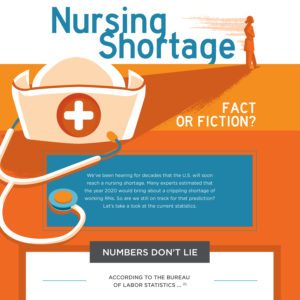The Nursing Shortage Fact of Fiction infographic summarizes the significant shortage of nurses in the healthcare industry and ideas for a solution.
Nursing Shortage: Fact or Fiction?
We’ve been hearing for decades that the U.S. will soon reach a nursing shortage. Many experts estimated that the year 2020 would bring about a crippling shortage of working RNs. So are we still on track for that prediction? Let’s take a look at the current statistics.
Numbers Don’t Lie
Featured Programs
According to the Bureau of Labor Statistics, there were 2,751,000 registered nursing jobs in 2014. Furthermore, the growth rate between 2014 and 2024 is expected to be 16%, much faster than average. Additionally, 439,300 more jobs will be created between 2014 and 2024.
Three reasons for expected growth in nursing positions
1. An emphasis on preventive care
More people are participating in routine check-ups and diagnostic tests that screen for cancer, diabetes, heart disease, and more.
2. The growing rates of chronic conditions like diabetes and obesity
- 1.4 million new cases of diabetes are diagnosed each year.
- 68.8% of adults in the U.S. are considered overweight or obese.
3. The demand for healthcare as the baby boomer generation lives longer and more active lives
- There are 76.4 million baby boomers in the U.S., representing one-quarter of the population.
- The ages of currently working nurses say it all. Once the majority of nurses retire, there will be few left to take their place.
- The average age of working RNs in the U.S. is 43.3.
- Nurses younger than 30 only accounts for 10% of the working nurse population.
- Associate professors of nursing average age of 52.
- The American Nurses Association estimates that 500,000 seasoned RNs are expected to retire in 2022.
- There will be 100,000 unfilled nursing jobs each year until then.
- The U.S. will need to produce 1.1 million nurses in order to avoid a shortage.
Is Meeting the Shortage Even Possible?
Not according to the numbers of nursing students coming out of RN programs. In 2015, almost 155,000 nursing graduates entered the workforce. If this trend continues, there will be no way to reach 1.1 million nurses in five years.
Nursing schools had to turn away 79,659 applicants in 2012 due to a professor shortage. That’s almost 80,000 nurses the U.S. will never have. It seems the U.S. really is headed for a nursing shortage of troublesome proportions.
How to Avoid a Shortage
Apart from reducing the number of beds in hospitals or closing facilities altogether, there are a few solutions to the nursing shortage problem.
1. Make nursing a more attractive profession for newcomers and college students
This would include shorter hours, higher pay, and more partnered care with physicians.
2. Reach out to youth
Implementing more programs that educate teens on the nursing profession and its benefits will help with recruitment numbers in college.
3. Survey current nurses for answers
Current working RNs can provide valuable insight into what changes or added benefits might keep them in the profession longer.
4. Train more nurses to become teachers
If more nurses could easily become adjunct faculty for nursing schools, more students could enroll and be trained by working professionals.
5. More training programs
Training programs provide clear paths for professional RNs and allow them to specialize in chosen areas. More specialization would mean a higher annual salary.
6. Give nurses more autonomy
With more training, nurses should be afforded more responsibilities within their area of specialty, including diagnosis and prescription power for nurse practitioners.
7. Advocate for Title VIII of the Public Health Service Act
This would increase funding for nursing education programs in the U.S.
Related:

